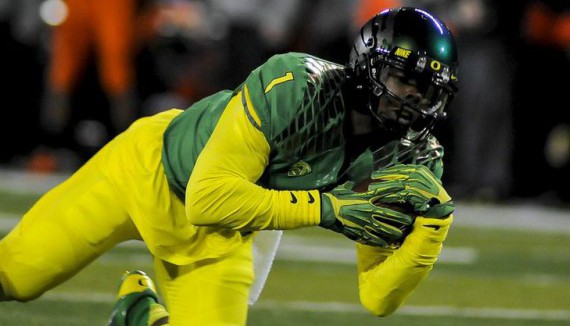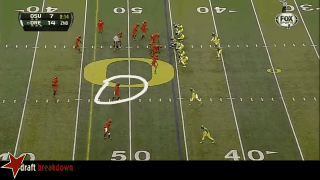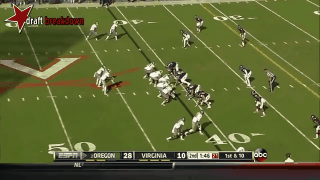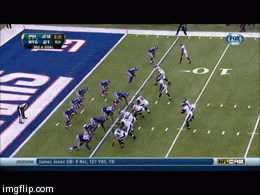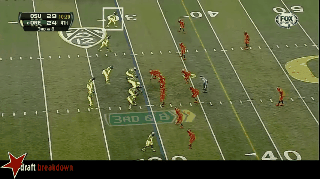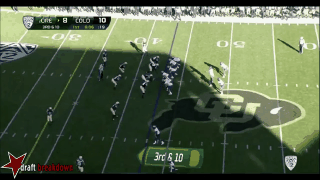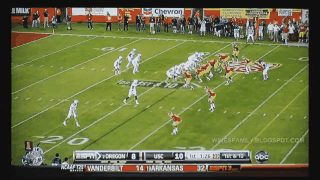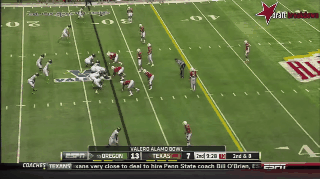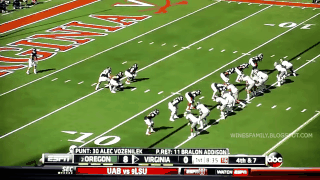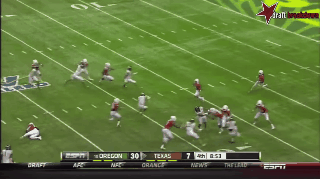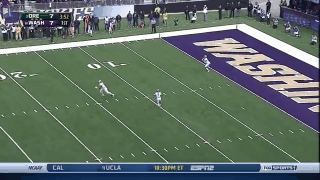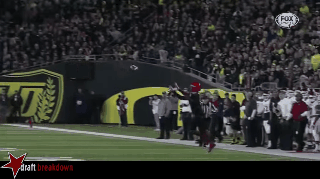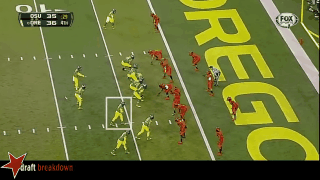It’s only year two of the Chip Kelly era in Philadelphia, and the Eagles have already overhauled their receiver group. They released three-time Pro Bowler DeSean Jackson and veteran slot receiver Jason Avant. They re-signed Riley Cooper and Jeremy Maclin. Then, they traded up in the second round of the 2014 NFL Draft to select Vanderbilt’s Jordan Matthews, but the front office wasn’t out of the receiver market yet. In the third round, the Eagles reunited Kelly with former Oregon receiver Josh Huff. This final move is evidence that Kelly has a consistent vision for the role of receivers in his offense.
Kelly wants receivers to be effective blockers, along with playing their more glamorous role as pass-catchers. Calling Huff aggressive and physical would be an understatement. On this play, he demolished a Texas defensive back.
He plays not only aggressively, but disciplined. Averse to drawing penalties, in the clip below Huff patiently waited for a UCLA defender to turn toward him before flattening him.
Last season in Philadelphia, Avant was a superb blocker from the slot. This block opened a lane which led to a LeSean McCoy touchdown in the “Snow Bowl” against the Detroit Lions.
Here’s another great block by Avant against the Washington Redskins:
Similar to Avant, Huff was primarily a slot receiver last season. Huff (4.51-second 40 time) might not have overwhelming speed such as Jackson’s (4.35), but he is still an upgrade in this area over Avant (4.73).
With two safeties each committed to covering a tight end on this play, Huff got a one-on-one matchup in man coverage. Huff has impressive fluidity, which gave him an advantage against this Oregon State defensive back. A sudden cut to the inside provided him with all the separation he needed for a huge gain.
In Philadelphia, Jackson primarily was the z-receiver under Kelly and Andy Reid, but both of those coaches moved him to the slot for a minority of snaps. Kelly beautifully designed this play, as Cooper ran a drag route over the middle which caused the Vikings safety to hesitate, helping the cornerback covering Jackson. The result was a big mismatch. Jackson raced past the cornerback in single coverage.
Kelly and his successor at Oregon, Mark Helfrich, want flexibility to use their slot receivers in the middle of the field to exploit slower linebackers and safeties. Huff (206 lbs.) is built better to absorb hits over the middle than Jackson (175), but he is still speedy enough to create a mismatch. In the following clip, his superb footwork gave him separation to run an effective slant route over the middle.
Huff also excels at creating space for himself by jumping up for the ball. Quarterback Marcus Mariota deserves credit on this play, as well, for recognizing the tight coverage by the Virginia defensive back and throwing the ball to a spot where only Huff can get it. Huff did his part by timing his jump perfectly.
In the pros, even Jackson maximizes his small frame to create space by timing his jump perfectly in tight coverage. Eagles quarterback Nick Foles anticipated Jackson’s jump on this play perfectly, similar to how Mariota timed Huff’s.
These kinds of plays require excellent concentration. Huff has exhibited this trait throughout his career when dealing with passes that were difficult to catch in traffic.
Huff brought versatility to Kelly’s offense by playing multiple roles. In addition to playing slot receiver, he played some snaps on the outside.
He took advantage of the poor communication and bad tackling among the Oregon State secondary in the 2013 Civil War game. The middle of the field was wide open, as two backs were open on screens and slot receiver Daryle Hawkins ran a slant route. Defensive backs diverted their attention to these guys, which gave Huff a nice cushion to run his post route in front of the deep safeties.
Huff also saw a significant number of snaps from the backfield at Oregon. He was one of several players who had a role in Kelly and Helfrich’s offense called the TAZR, a hybrid running back/wide receiver/tight end.
In his freshman season, Huff was often the pitch-man on Oregon’s triple option runs. Since Huff will be wearing midnight green this year, keep an eye out for triple options in Philadelphia.
Here is one from last season against Colorado:
In 2010, there was a rare occasion when Huff got to run on a power play between the tackles. Huff had enough durability to make the reward greater than a risk on this inside run.
It’s possible Kelly will design similar plays with Huff in the backfield, but it is more likely that Darren Sproles will get these touches because of his more extensive experience as a member of the New Orleans Saints.
Kelly shouldn’t send his TAZRs up the middle on inside power runs too much, but a moderate use of these plays could be deadly for defenses anticipating an attack on the perimeter. The expectation that TAZRs will attack the perimeter also opens up space for other players.
On this play, Huff was the motion man from the backfield. He drew the attention of the linebacker, which left a 5-on-5 match-up between the offensive line and defensive box. The threat posed by Huff opened a hole for running back De’Anthony Thomas.
Along with his skillset on offense, Huff provides the Eagles with an aptitude of making plays on special teams. Here are a few examples:
Special teams playmakers are an even more valuable commodity in the NFL than in college football. With only 46 spots on the gameday roster, it is crucial for NFL head coaches to weigh special teams contributions in personnel decisions. Huff will have an edge here.
There are some aspects of Huff’s game which could diminish his productivity in the NFL. Although he made some beautiful catches in Oregon, there are some plays he’d like to have back. They showed his lapses in concentration and timing, an inconsistency he will need to improve in the NFL.
Huff also displayed a tendency to get thrown off his route.
It will be crucial for Huff to improve against tight coverage. While Oregon rarely faced press coverage, the Eagles faced a lot of press man coverage late in the season. Huff must adapt to the more physical style of play which awaits him.
Bottom Line
There’s plenty of room in Kelly’s offense for Huff to get catches, despite the deep group of receivers competing with him. In mini-camp, the Eagles used a four-receiver look with Cooper, Huff, Matthews, and Maclin. Expect to see that formation appear a significant amount this season. Huff will probably play on most of the Eagles’ special teams units, as well. It’s possible he’ll return kicks this season, although he will have to beat out the veteran Sproles for that job.
Huff’s familiarity with Kelly’s playbook and coaching style can only help him. He will have every opportunity to become a prized weapon on Kelly’s team for the second time.
Top Photo by Craig Strobeck
Joe Kearns is a senior at the Pennsylvania State University majoring in Economics. He intends to pursue a career in the banking and financial services industries, but is also a lifelong diehard Philadelphia Eagles fan who enjoys analyzing college and pro football film as a hobby. Along with being a fan, Joe’s football knowledge comes from his days as a center, defensive tackle, and long snapper for his high school in Mt. Lebanon, Pa. Though he is a Nittany Lion, he has taken a great interest in the Oregon football team since Chip Kelly became the Eagles head coach. He loves pancakes ( and not just the breakfast food).

